So, how do fitness trackers work, and do they actually respect privacy policies? Learning how fitness trackers work is essential to understanding their limits and using them in the best way possible to improve your health and collect necessary data.
Table of Contents
ToggleHowever, my experience tells me people also seek to understand how these wearable pieces of technology work for their personal privacy reasons.
In fact, a study from PubMed Central titled “Fitness Tracker Information and Privacy Management: Empirical Study” found that at least one in five Americans use a device or an app to track their fitness-related activities. Also, the findings of the same study show that people are willing to share their personal fitness information if they have granular privacy control over it [1].
Understanding how these fitness gadgets work is a must because they are also shown to benefit your daily activity levels and overall motivation.
Another study from the British Medical Journal found that using activity monitors encouraged individuals to take an extra 1,235 steps daily and also to do 49 additional minutes of moderate-to-vigorous physical activity weekly [2].
Valuable information from the study above was my motivation to undertake a thorough 35-hour research to find out how fitness trackers work. It seems to me that people are more likely to use these gadgets if they understand how they work, what their impact is, and whether their data is safe.
Start Building Your Dream Body Today
Ready to elevate your fitness game without falling into the trap of dull, repetitive routines that just don’t deliver? Imagine sculpting your ideal physique and boosting your health, all while still enjoying life’s pleasures, like those irresistible weekend getaways and your aunt’s legendary cheesecake. With our online fitness and nutrition coaching service, you don’t have to compromise. Dive into a personalized fitness journey that blends perfectly with your lifestyle, not against it. Book your completely free discovery consultation today, and take the first step towards a transformation that doesn’t require giving up the joys of life.

“I was skeptical about online fitness coaching, but Functional Body Savage completely changed my perspective. Vanja and Radomir’s personalized approach and attention to detail have helped me achieve goals I never thought possible. I’m stronger, more confident, and grateful for their guidance.”
Emily Thompson, San Francisco, CA
Learn More About Our Online Coaching ServiceQuick Summary
- Fitness trackers work by utilizing sensors and algorithms to track and analyze physical activities, heart rate, sleep patterns, and other health metrics, enhancing users’ understanding of their fitness and health.
- These devices collect data through accelerometers, gyroscopes, and heart rate monitors and sync this information to smartphones or computers for detailed analysis and progress tracking.
- A study from the British Medical Journal indicates that using activity monitors leads to an increase in physical activity, with individuals taking an extra 1,235 steps daily and engaging in 49 more minutes of moderate-to-vigorous physical activity weekly.
- In my experience, understanding the functionality and data privacy of fitness trackers is crucial for maximizing their benefits and ensuring personal data security.
How Do Fitness Trackers Work?
Fitness trackers work by using a combination of sensors and algorithms to monitor and record various physical activities and health metrics. They employ accelerometers and gyroscopes to detect motion and orientation, which helps in counting steps, measuring distance, and identifying the type of physical activity.
For heart rate monitoring, they use optical heart rate sensors that detect blood volume changes in the wrist through light-based technology. Some trackers also include GPS to map outdoor activities and track parameters like distance and speed, while altimeters are used to measure elevation gains during activities such as hiking.
Software algorithms then interpret the data collected by these sensors to provide insights on calories burned, sleep quality, workout intensity, and more. This information is synced to a smartphone or computer via Bluetooth or Wi-Fi, allowing users to analyze their data, track progress, and sometimes share their achievements socially.
The user interface, either on the device itself or through a companion app, displays this data and allows users to interact with the device, set fitness goals, and monitor their health and fitness progress. Through this combination of technology and user interaction, wearable fitness trackers offer a comprehensive view of an individual’s physical activity and health, promoting a more active and healthier lifestyle.
How Does a Fitness Tracker Measure Steps?
A fitness tracker measures steps primarily using an accelerometer, a small motion sensor that detects movement and orientation. When you walk or run, your body produces distinct motion patterns.
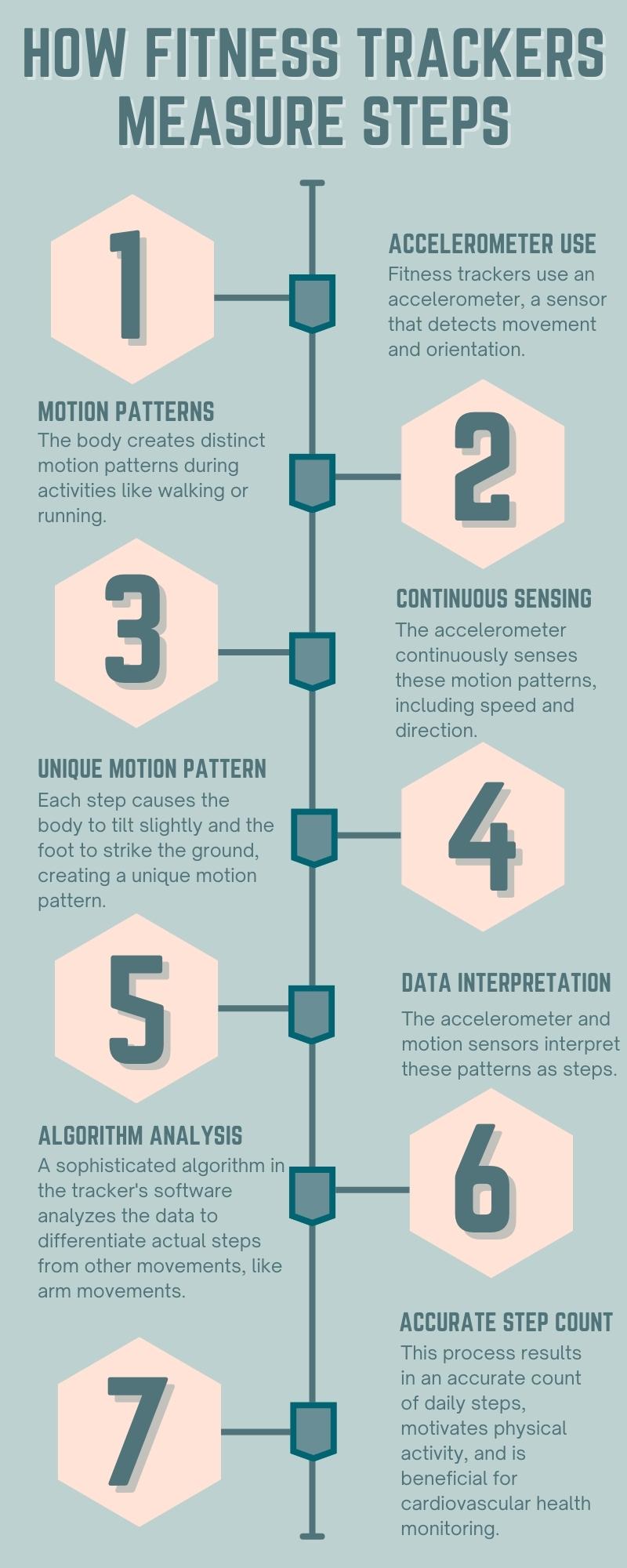
The accelerometer in the wearable tracker continuously senses these patterns, including the speed and direction of movement. Each time you take a step, your body tilts slightly, and your foot strikes the ground, generating a unique motion pattern. The accelerometer and motion sensors interpret these patterns as steps.
The sophisticated personalized algorithm within the tracker’s software analyzes the accelerometer data to differentiate between steps and other movements, like simply moving your arm, to avoid false step counts.
In my daily use, I’ve noticed how the tracker continuously collects and processes movement data. It’s impressive how it analyzes the frequency and intensity of my movements, giving me an accurate count of my daily steps, which has been a great motivator for staying active. It’s also great for those battling a cardiovascular disease.
While wrist-worn trackers are common, ankle fitness trackers can offer a different experience, especially for activities like cycling. In fact, studies even suggest that ankle fitness trackers are more accurate than wrist-worn ones. Learn more about them in our detailed article on the best ankle pedometer.
How Does a Fitness Tracker Measure Energy Expenditure?
A fitness tracker measures energy expenditure by combining data from various sensors and applying algorithms to estimate the number of calories burned.
The process involves several steps:
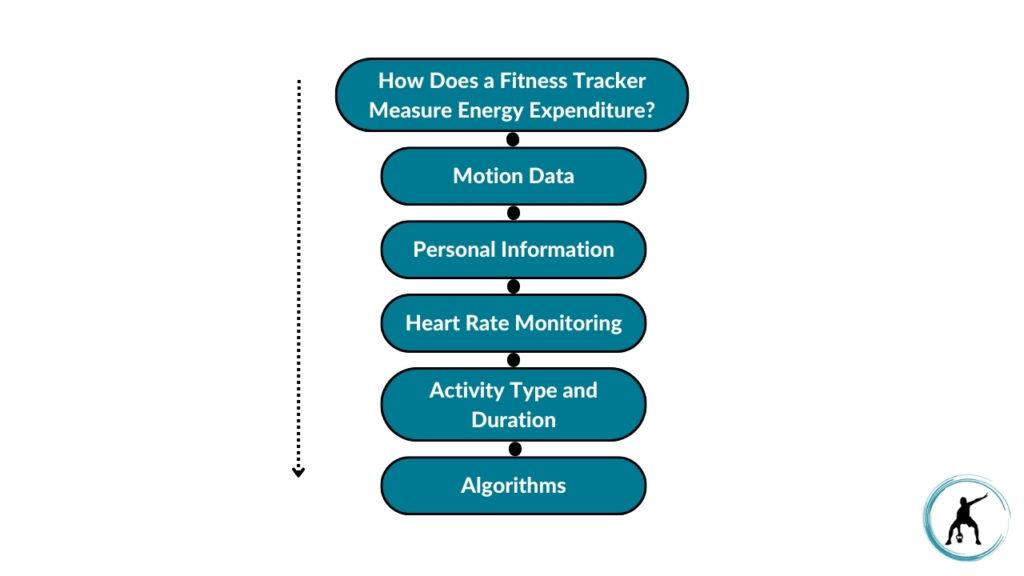
Motion Data
The tracker uses an accelerometer to accurately assess physical activity, such as walking forward, running, or cycling. This motion data provides a baseline for estimating energy expenditure.
Personal Information
When setting up the tracker, users typically input personal data like age, gender, weight, and height. This information about you and your body composition is crucial because energy expenditure varies based on these individual characteristics.
Heart Rate Monitoring
Many wearable fitness trackers include optical heart rate sensors. By monitoring heart rate, the tracker can estimate the intensity of the activity. Higher-intensity activities generally burn more calories.
Activity Type and Duration
The tracker identifies the type of activity being performed and its duration. Different activities burn calories at different rates. For example, running will typically burn more calories than walking for the same duration.
Algorithms
The tracker’s software uses algorithms to integrate this data – motion, personal information, heart rate, activity type, and duration – to estimate the total energy expenditure or calories burned.
How Does a Fitness Tracker Measure Heart Rate?
A fitness tracker measures heart rate using a technology called photoplethysmography (PPG). This method involves an optical heart rate sensor, typically located on the back of the tracker, which stays in contact with the skin.
The sensor emits a green light that penetrates the skin and is absorbed by the blood flowing through the wearer’s wrist. When the heart beats, the blood flow in the wrist increases, leading to more absorption of light.
Between beats, less light is absorbed. The tracker’s software analyzes these variations in light absorption to calculate the heart rate. This process allows the fitness tracker to continuously monitor heart rate, providing real-time data and insights into cardiovascular health and workout intensity.
These devices are not just for the tech-savvy; they’re also ideal for seniors who prefer simplicity. For senior-friendly options that don’t require a smartphone, check out our guide on the best fitness tracker that doesn’t require a smartphone.
How Does a Fitness Tracker Track Your Sleep?
A fitness tracker tracks sleep by using a combination of an accelerometer and software algorithms. The accelerometer, which is crucial for sleep tracking, detects physical movement, which is minimal during sleep.
When you wear the tracker to bed, it monitors your movements throughout the night, distinguishing between periods of restlessness and stillness. The software then analyzes these movement patterns to determine the duration and quality of your sleep, including the time spent in different sleep stages, such as light, deep, and REM sleep.
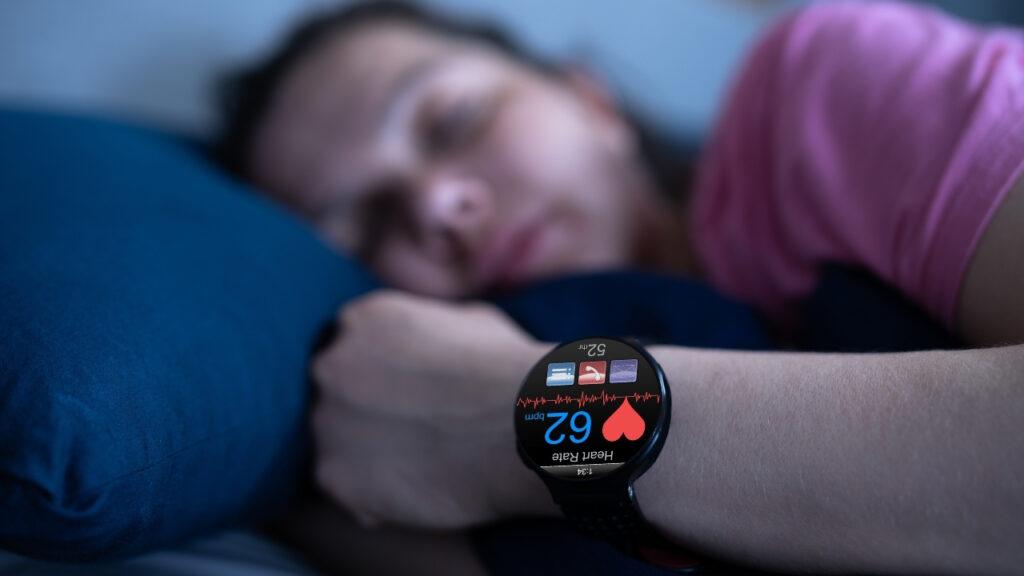
Do Fitness Trackers Collect My Private Data?
Yes, fitness trackers do collect your private data. When you use a fitness tracker, it gathers a range of information about your physical activities, health metrics, and sometimes even location data if it has GPS functionality.
This can include details like the number of steps you take, your heart rate, sleep patterns, and workout routines. Additionally, when setting up the tracker, you might input personal information such as age, weight, height, and gender, which the device uses to provide more personalized insights.
In That Case, Is My Private Physical Activity Data Safe?
The safety of your private physical activity data collected by wearable fitness trackers largely depends on the security measures implemented by the manufacturer, the wearable tech used, and how you manage your data privacy settings.
Here are some key points to consider:

Manufacturer’s Security Protocols
Reputable fitness tracker brands typically employ various security measures to protect user data. However, the level of security can vary between manufacturers and models.
Data Encryption
Check if the data transmitted from your device to the cloud or your smartphone is encrypted. Encryption helps protect your data from being easily accessed if intercepted.
Privacy Policy
Review the privacy policy of the fitness tracker to understand what data is collected, how it is used, and whether it is shared with third parties.
Software Updates
Regular software updates often include security patches. Keeping your device and associated apps updated is crucial for protecting your data.
Personal Data Management
Be cautious about the amount and type of personal information you share with the fitness tracker app. Use strong, unique passwords and enable two-factor authentication if available.
Potential Data Breaches
Like any technology that collects and stores data, there is always a risk of data breaches. Staying informed about any reported breaches related to your fitness tracker is important.
Is a Wearable Fitness Tracker Good for Scientific Research?
A wearable fitness tracker can be beneficial for scientific research as it provides large-scale, real-time data on physical activity, heart rate, and other health metrics. However, the data’s reliability can vary based on the device’s quality and the specific metrics being measured.
Researchers need to consider the limitations and potential biases in the data collected from these devices.
How Accurate Are Wearable Fitness Trackers?
In terms of accuracy, wearable fitness trackers are generally good at tracking steps and basic physical activity. Still, they can vary in precision for more complex measurements like calorie burn or sleep quality.
The accuracy of heart rate monitoring has improved with advancements in technology. However, it may still not match the precision of medical-grade devices, especially during high-intensity activities or for individuals with certain health conditions.
If you’re looking for a specialized fitness tracker for pushing a pram, our comprehensive buyer’s guide has you covered.
What Features Do Modern Fitness Trackers Have?
The features that modern fitness trackers have are an accelerometer, gyroscope, altimeter, optical heart rate sensor, temperature sensor, GPS, pedometer, ambient light sensor, touchscreen interface, and Bluetooth connectivity.
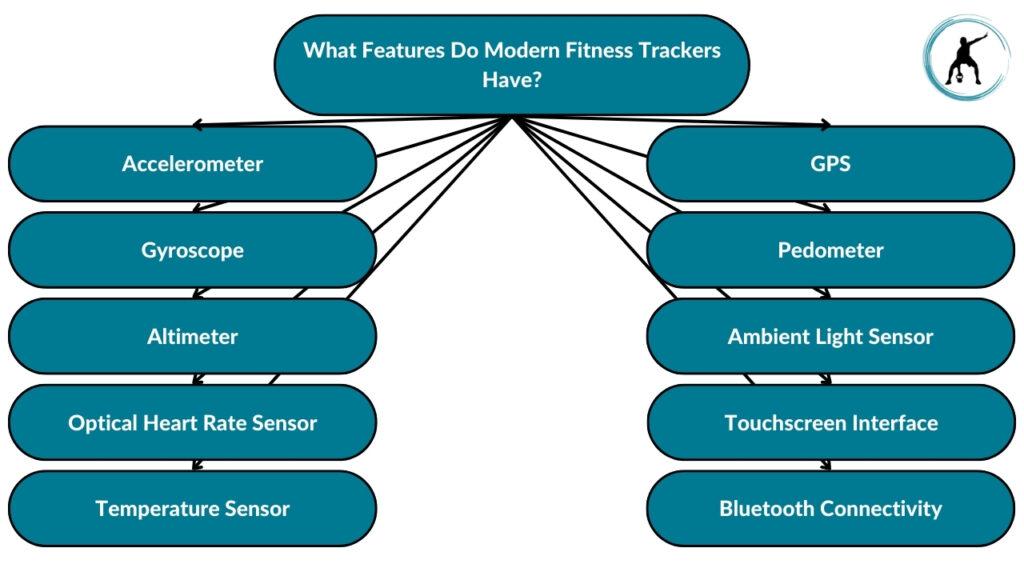
Let’s cover each of these below.
Accelerometer
The accelerometer in a fitness tracker detects and measures linear acceleration. It’s fundamental for tracking steps and identifying movement patterns, such as speed and direction changes, making it essential for calculating physical activities like walking or running.
Gyroscope
A gyroscope in a fitness tracker helps determine orientation and angular velocity. It works alongside the accelerometer to provide more accurate data on the device’s position and motion, enhancing the tracking of specific exercises and activities.
Altimeter
An altimeter measures altitude which is used to track elevation gains and losses. This feature is particularly useful for activities like hiking or stair climbing, as it helps in calculating the intensity of workouts involving changes in height.
Optical Heart Rate Sensor
This sensor uses light-based technology to measure blood flow through the skin, providing continuous heart rate monitoring. Optical heart rate monitors are crucial for tracking workout intensity, calorie burn, and overall cardiovascular health.
If you are into cardio and you simply love running, the king of all cardio exercises, you might want to check our guide on the best fitness trackers for treadmills. These wearable devices are specifically tailored for treadmill use. They will help you stay more motivated during long cardio workouts while also giving you specific insights into your health you weren’t aware of before.
Temperature Sensor
The temperature sensor in a fitness tracker monitors ambient and body temperature. This feature can provide insights into environmental conditions during workouts and potentially detect fever or illness.
GPS
GPS in fitness trackers offers precise location tracking, which is essential for mapping outdoor activities like running and cycling. It provides detailed data on speed, distance, and route, enhancing the accuracy of workout metrics.
Pedometer
A pedometer counts steps by detecting motion, typically through an accelerometer. This feature is key for tracking daily physical activity levels and encouraging users to meet their step count goals according to their fitness level.
Ambient Light Sensor
This sensor detects the surrounding light levels, adjusting the display brightness accordingly for better visibility and battery efficiency. It can also be used to track exposure to natural light, contributing to sleep and activity analysis.
Touchscreen Interface
The touchscreen interface on a fitness tracker offers an intuitive way to navigate through the device’s features. It allows users to interact with the device, view their data, and customize settings easily.
Bluetooth Connectivity
Bluetooth connectivity enables the fitness tracker to sync data wirelessly with smartphones or computers. This feature allows for the transfer of fitness data to apps for detailed analysis, progress tracking, and sharing information with health apps or social networks.
How to Set up a Fitness Tracker?
To set up a fitness tracker:
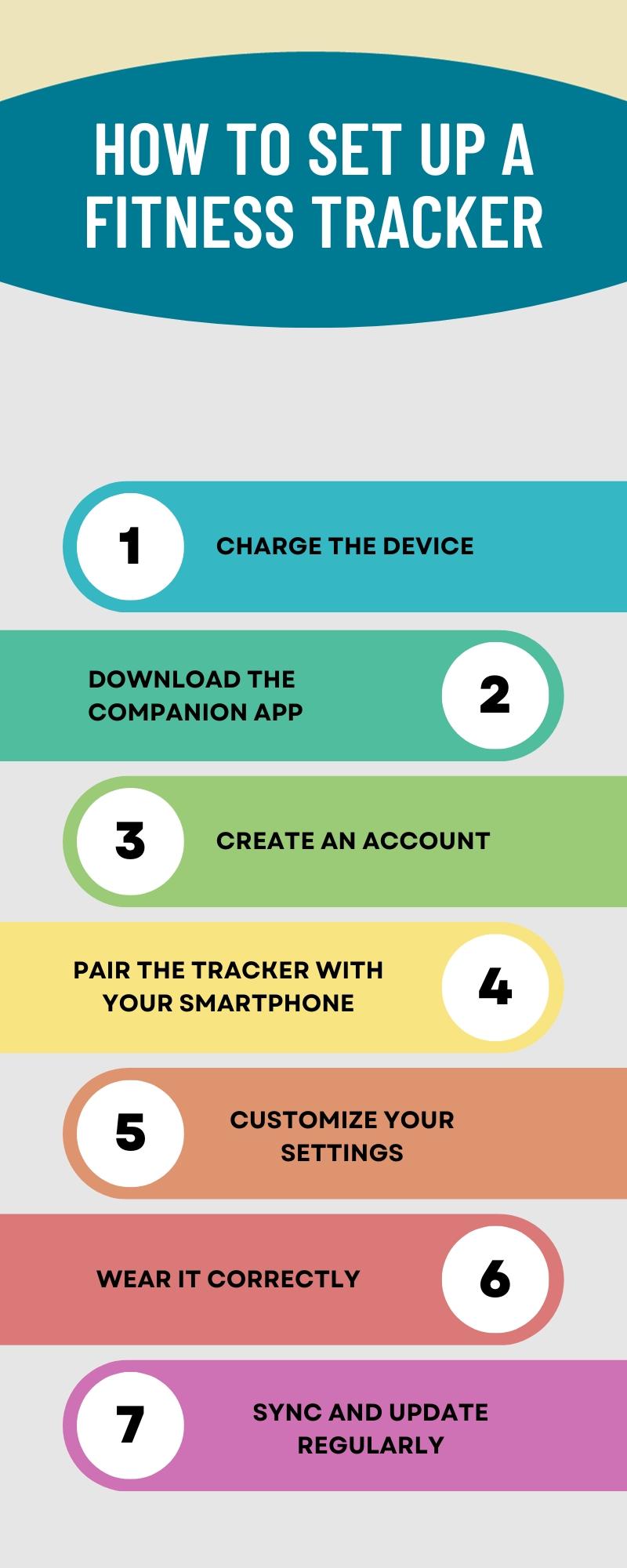
Charge the Device
Before starting, ensure your fitness tracker is fully charged. This prevents any interruptions during the setup process.
Download the Companion App
Most fitness trackers are managed through a companion app on your smartphone. Download the app specific to your fitness tracker from the App Store (for iOS devices) or Google Play Store (for Android devices).
Create an Account
Open the app and create a new account if you don’t already have one. You’ll likely need to provide some basic information like your email address, age, weight, height, and gender. This information helps personalize your fitness tracking experience.
Pair the Tracker with Your Smartphone
Turn on Bluetooth on your smartphone. Follow the instructions in the app to pair your fitness tracker with your phone. This usually involves pressing a button on the tracker or selecting it from a list in the app.
Customize Your Settings
Once paired, you can customize various settings, such as goals for steps, sleep, and exercise, as well as notifications for calls, texts, and app alerts.
Wear It Correctly
For accurate data, wear the fitness tracker as recommended by the manufacturer, usually snugly on your wrist.
However, for those with smaller wrists, finding the right fitness tracker is crucial for comfort and accurate data collection. Discover some of the best options in our guide on the best wearable fitness trackers for smaller wrists.
Sync and Update Regularly
Regularly sync your tracker with the app to update your data. Ensure your tracker’s firmware is up to date for the best performance and latest features.
FAQs
How Do Fitness Trackers Know How Many Calories You Burn?
Fitness trackers know the number of calories you burn by combining data from their sensors, like the accelerometer and heart rate monitor, with personal details such as your age, weight, and gender. This information is processed through algorithms to provide an approximation of calorie expenditure during various activities.
Do Fitness Trackers Really Help?
Yes, fitness trackers really help by motivating individuals to increase their physical activity, providing data on their health metrics, and enabling them to track and achieve their fitness goals. They offer insights into daily activity levels, sleep patterns, and workout effectiveness, which can encourage a healthier lifestyle.
How Do Fitness Trackers Collect Data?
Fitness trackers collect data using built-in sensors such as accelerometers, gyroscopes, and heart rate monitors, which track movement, orientation, and physiological metrics. Algorithms then process this data to provide insights into steps taken, calories burned, sleep quality, and other health-related metrics.
Do Fitness Trackers Sell Your Data?
The policy on selling data varies among fitness tracker companies; some may share or sell anonymized data with third parties for research or marketing, while others prioritize user privacy and do not sell personal data. Users need to review the privacy policy of their fitness tracker to understand how their data is handled and potentially shared.
How Many Calories Does 10,000 Steps Burn?
The number of calories burned by walking 10,000 steps varies depending on factors like a person’s weight, walking pace, and terrain, but on average, it can range from 300 to 500 calories. This estimation is based on general calculations and can differ significantly from person to person.
Wrapping Up
Wrapping up my extensive 35-hour research into how fitness trackers work, I’ve come to appreciate the intricate balance between their technological capabilities and the privacy concerns they raise.
These devices, equipped with various sensors and algorithms, do an impressive job of tracking our physical activities, heart rate, and even sleep patterns, offering valuable insights into our overall health and fitness.
However, as someone deeply invested in understanding both the benefits and the potential drawbacks, I recognize the importance of managing privacy with these devices. Studies, including one from PubMed Central, highlight that users are more comfortable sharing their data when they have control over their privacy.
Start Building Your Dream Body Today
Ready to elevate your fitness game without falling into the trap of dull, repetitive routines that just don’t deliver? Imagine sculpting your ideal physique and boosting your health, all while still enjoying life’s pleasures, like those irresistible weekend getaways and your aunt’s legendary cheesecake. With our online fitness and nutrition coaching service, you don’t have to compromise. Dive into a personalized fitness journey that blends perfectly with your lifestyle, not against it. Book your completely free discovery consultation today, and take the first step towards a transformation that doesn’t require giving up the joys of life.

“I was skeptical about online fitness coaching, but Functional Body Savage completely changed my perspective. Vanja and Radomir’s personalized approach and attention to detail have helped me achieve goals I never thought possible. I’m stronger, more confident, and grateful for their guidance.”
Emily Thompson, San Francisco, CA
Learn More About Our Online Coaching ServiceReferences:
- Abdelhamid M. Fitness Tracker Information and Privacy Management: Empirical Study. J Med Internet Res. 2021;23(11):e23059. Published 2021 Nov 16. doi:10.2196/23059
- Larsen R T, Wagner V, Korfitsen C B, Keller C, Juhl C B, Langberg H et al. Effectiveness of physical activity monitors in adults: systematic review and meta-analysis BMJ 2022; 376 :e068047 doi:10.1136/bmj-2021-068047





